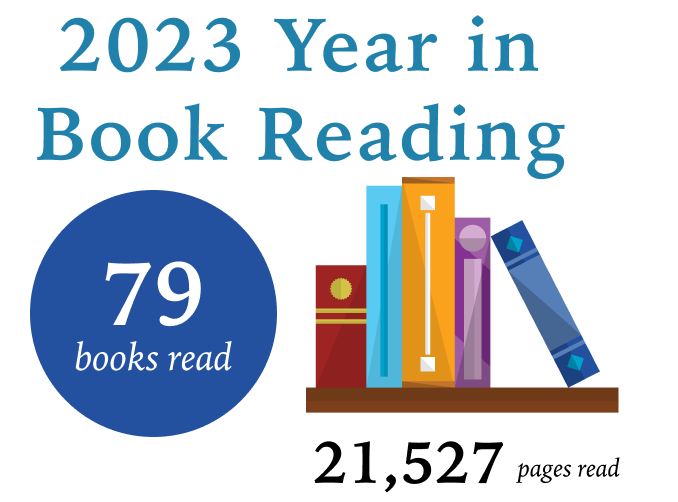If you dedicate just 30 minutes a day to book reading for a year, you can easily finish between 30 and 40 books in a year.
Here are my reading stats and recommendations from my latest year-in-book-reading!
According to my reading logs, I read a total of 79 books spanning 21,527 pages this past year. This past year the average length of a book I read was about 272 pages. By my calculation, it took me less than an hour per day dedicated to book reading. Assuming 300 words per page, that’s roughy 6.4 million words read. Awhile back I estimated my reading speed at around 300 words per minute. That means that I read these 79 books and 21.5k pages in roughly 358.75 hours. Put simply, it took me less than an hour per day dedicated to reading to complete
Compared to the previous year (2022) when I read 58 pages and 17,365 pages, this last year (2023) is a total books read increase of nearly 38% and total pages read increase of about 24%.
According to my kindle highlights log, I took 4,433 book highlights this last year across 102 total books with an average of 43.5 highlights per book. My kindle highlights also make it easier to capture, review and synthesize what I learn from the books I read, which often comes in the form of smart notes and blog posts.
Wanna read more books? My Tip: Read 30 minutes to an hour everyday. How? First, ditch the social media, quit YouTube, and block off your worst phone habits. Then, give yourself the gift of book reading about as often as you want and can. Find time ideally everyday in the evenings and regularly during the day, perhaps even at lunch.
In this post, I’d like to share my recommendations of my favorite books read this past year as well a few data visualizations from my book reading year and selection and note on some of my favorite books. I’ll conclude with a reflection on my book reading and my intentions for year ahead.
FYI – If you are interested in more detailed data logging and tracking practices, I log my reading with Goodreads, Kindle and Instapaper. Data collection and visualization powered by QS Ledger. This post and a few related ones are part of my Year in Data project.
79 books Books Read. 21,527 pages read.
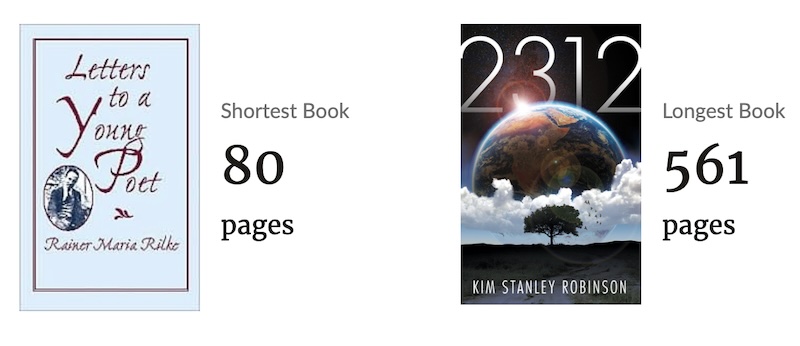
Book Reading Highlights: 4,433 book highlights total book highlights
So what were my most commonly highlighted words in 2023?

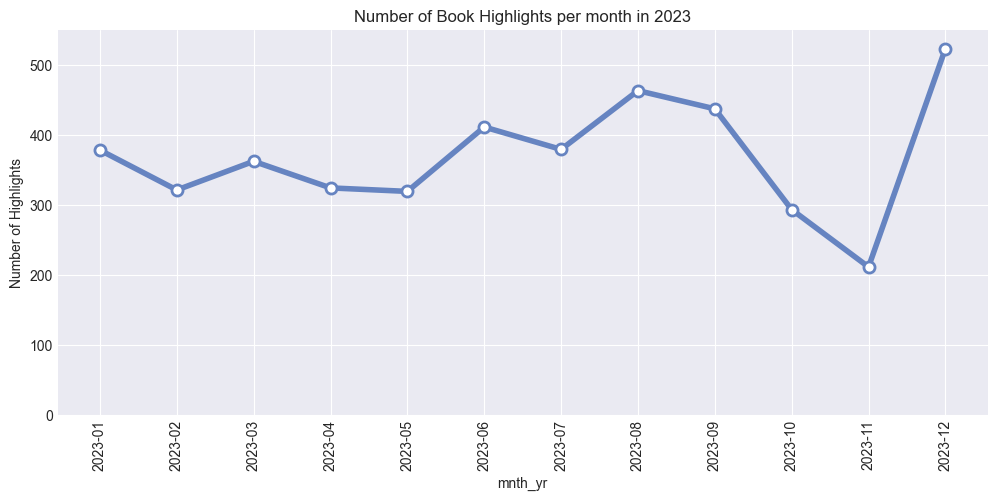

Average of 43.5 highlights per book
My Top Highlighted Books:
- 228 in Theory of Society
- 215 in Panama fever: the epic story of one of the greatest human achievements of all time–the building of the Panama Canal
- 188 in Rough-Hewn Land
- 174 in Central America’s Forgotten History
- 166 in The Encyclopedia of Taoism
- 163 in I, Rigoberta Menchu
- 158 in Wanting
- 153 in The Creative Act
- 152 in Through the Language Glass: Why the World Looks Different in Other Languages
- 144 in The Art of Impossible
- 142 in The History and Ethics of Authenticity: Meaning, Freedom, and Modernity
- 126 in The Blank Slate: The Modern Denial of Human Nature
- 125 in The Maya: A Very Short Introduction
- 115 in The Arts and the Definition of the Human
- 113 in Outlive
- 95 in Man’s Search For Meaning: The classic tribute to hope from the Holocaust
- 94 in The Art of Self-Improvement
- 94 in Daily Rituals How Artists Work
- 92 in Basic writings of Nietzsche
- 86 in Tales of the Taoist Immortals
My 2023 Book Recommendations:
Check out Goodreads for a list of all of the books I read in 2023. Below are a few recommendations on my favorite books and a brief note, quote or thought on each.
(If you are interested in more book recommendations, check out my Recommended Books page.)
Favorite Novel or Fiction: Overstory by Richard Powers
Watchman touches her shoulder. “What’s crazier—plants speaking, or humans listening?”
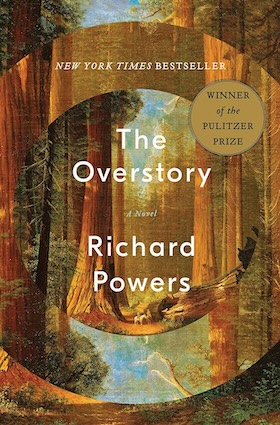
The Overstory is a vivid novel by Richard Powers that explores the relationship between humans and nature. It specifically focuses on and weaves an engrossing plot centered on the lives of several individuals and the expriences with tress that deeply impacted them. It includes wonderful, though seemingly disconnected, character sketches in the first half of the book.
Death races across Connecticut and Massachusetts, jumping dozens of miles a year. Trees succumb by the hundreds of thousands. A country watches dumbstruck as New England’s priceless chestnuts melt away. The tree of the tanning industry, of railroad ties, train cars, telegraph poles, fuel, fences, houses, barns, fine desks, tables, pianos, crates, paper pulp, and endless free shade and food—the most harvested tree in the country—is vanishing.
In the later parts of the book, multiple storylines are brought back together, including a scientist studying the communication patterns of trees, a woman who inherits a forest and becomes an activist, and a man who becomes an eco-terrorist. Along the way, we encounter a variety of characters who all, in their own way, grapple with the complex and often conflicted relationship between humanity and the natural world. Over time, the different storylines begin to intersect and overlap, as characters who were previously separate come into contact with one another. This creates a sense of a larger interconnected web, where every action and decision has ripple effects throughout the system.
Trees know when we’re close by. The chemistry of their roots and the perfumes their leaves pump out change when we’re near. . . . When you feel good after a walk in the woods, it may be that certain species are bribing you. So many wonder drugs have come from trees, and we haven’t yet scratched the surface of the offerings. Trees have long been trying to reach us. But they speak on frequencies too low for people to hear.
The book encouraged me think about the world in a more holistic way, and to recognize the complex relationships that exist between humans and the natural world. Beautifully written and told with an important ecological message.
Favorite “Made Me Think” Nonfiction Book: Through the Language Glass by Guy Deutscher
“There are four tongues worthy of the world’s use,” says the Talmud: “Greek for song, Latin for war, Syriac for lamentation, and Hebrew for ordinary speech.”
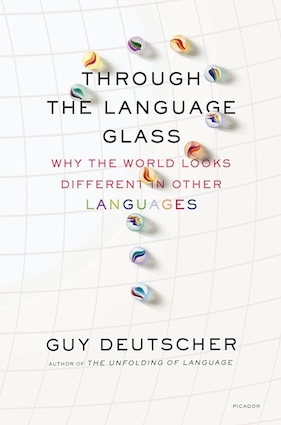
Is language a mirror to our mind? Does language reflect culture of a society? Can language lead speakers to different thoughts and perceptions?
In Through the Language Glass: Why the World Looks Different in Other Languages, Guy Deutscher explores the intricate relationship between language, culture, and perception.
Languages vary considerably in the amount of information they convey within words (rather than with a combination of independent words).
He dives in the linguistics, psychology, and cognitive sciences in order to try an answer whether or not language affects how we thinking? And if so, how?
The book provides a wealth of history on an evolving debate on impact of culture/language on our human nature. His core inquiry in a more scientifically precise formulation is: does our native language impact or influence our ability to and how we think and see the world? Does langauge lead or nudge speakers to different thoughts, perceptions and interpretations of the world? “We dissect nature along lines laid down by our native languages.” (Benjamin Lee Whorf, p 150)
Key point:
two distinct territories: the domain of labels and the land of concepts. The labels reflect cultural conventions, but the concepts reflect nature. Each culture is free to bestow labels onto concepts as it pleases, but the concepts behind these labels have been formed by the dictates of nature.
He offers three pieces of evidence:
- Colors and how we “see” - Notable historical evolution of color terms and perception. For instance, the absence of a word for “blue” in ancient texts like Homer’s poems. To quote, “Most striking is the lack of any word that could be taken to mean ‘blue.’ The word kuaneos, which in later stages of Greek meant blue, does make an appearance in the poems, but it must have just meant ‘dark’ for Homer, because he uses it for neither the sky nor the sea, only to describe the eyebrows of Zeus, the hair of Hector, or a dark cloud.”
- Spatial Orientation and Language: Languages like Guugu Yimithirr, which use cardinal directions instead of egocentric terms like “left” or “right,” affect how speakers perceive and describe space
- The gender systems in languages can influence speakers’ associations with objects. - For example, nouns with conflicting genders in German and Spanish lead speakers to associate different properties with these objects
Despite the influence of language on perception and categorization, there is no evidence that language limits our intellectual horizons or constrains our ability to understand concepts present in other languages
Honorable Mention: Wanting: The Power of Mimetic Desire in Everyday Life by Luke Burgis
Favorite Sci-Fi Book: 2312 by Kim Stanley Robinson
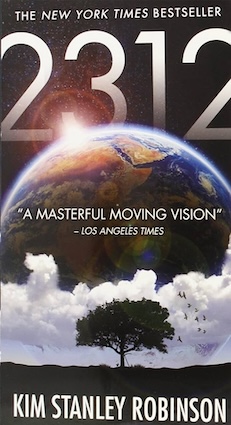
we are here to inscribe ourselves on the universe,
“2312” by Kim Stanley Robinson is a futuristic, science fiction novel that takes place in the year 2312. During this time humanity has colonized much of the solar system. The story is centered on the main character, Swan Er Hong, an artist and terrariuming designer (terraforming asteroids) who lives on Mercury. She gets caught up in a political and technological conspiracy that threatens the stability of the solar system.
Along with a suspenseful plot and detailed imaginations of humanity’s future settlements on other solar bodies, Robinson’s novel provides a deep reflection on the future of humanity, ecology, politics, sustainability and our evolving relationship with technology/AI. It is also a wonderful imagination of geoengineering too.
One of my favorite quotes in the book:
to form a sentence is to collapse many superposed wave functions to a single thought universe. Multiplying the lost universes word by word, we can say that each sentence extinguishes 10n universes, where n is the number of words in the sentence. Each thought condenses trillions of potential thoughts.
Honorable Mention Sci-Fi Favs
- Song for a New Day by Sarah Pinsker - Published pre-COVID-19 Pandemic, this book imagines a society in more or less permenant lockdown. The plot centers on the struggle for musicans and artists in particular our main female rocker protagonist to either perform online in VR (called StageHolo) or in underground, illegal shows.
- The Terraformers by Annalee Newitz - This is arguably one of the most uniquely imagined sci-fi tales I’ve read in awhile. Built on many similar ideas as Robinson’s 2312 and geoengineering, the story takes place on a corporate terraforming project and weaves in the rise of new sentient animals and robots, conflicts between different human species (namely Homo sapiens and Homo diversus) and the pursuit of economics and self-governing. Long live the Environmental Rescue Team (ERT).
- Pillar to the Sky by William R. Forstchen - While the plot and characters felt a bit wooden at time, I quite enjoyed this sci-fi geoengineering epic about constructing humanity’s first space elevator or skyhook.
Fantasy Favorite: Earthsea Cycle by Ursala K. Le Guin
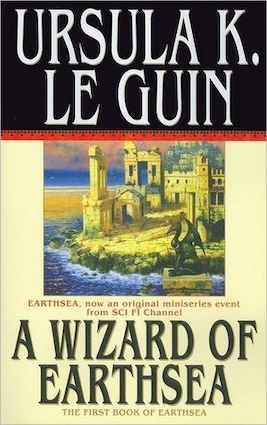
For magic consists in this, the true naming of a thing.
A Wizard of Earthsea by Ursala K. Le Guin is the first book in a series of high fantasy books. The story takes place in the world of Earthsea, a vast archipelago of hundreds of islands surrounded by mostly uncharted ocean and no large continents. The stark geography and geology are vividly portrayed, and I quite enjoyed the magic system found across the books, especially those of the dragons. The first book is a pretty classic fantasy arch while the later books take on more nuanced and even feminist concepts. Well-read and highly engaging fantasy with probing moral questions.
Honorable Mention: Kindred by Octavia Butler is a unique take on slave narratives with a spice of time travel. Brutal story at time but also brought to light many small details on slavery I didn’t know beforehand.
Favorite on Art and Creativity: Daily Rituals by Mason Currey
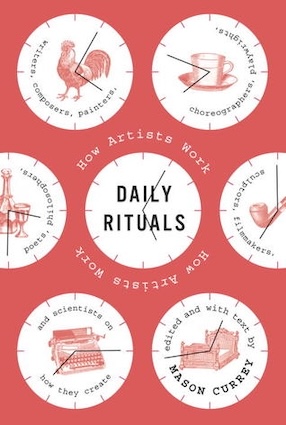
Daily Rituals by Mason Currey is a curious book about artists and their habits. Rather than dive into long-winded narratives on how artists and creatives should organize their offices, manage their time or seek inspiration, this book provides several dozen, dry factual accounts of just 3-4 pages descriping how specific individual artists lead their lives. Hard work and showing up are obviously key to a successful artist. But spanning a host of great artists, the book also highlights just how different the life of artist output and engagement varies. This book has inspired me in a small and big ways to push myself to create and live my own artistic rituals too.
Honorable Mentions:
- The Dictionary of Obscure Sorrows by John Koenig is creative foray into human emotions and words, shedding light on weird corners of the human condition. Its main challenge is to make us notice a nearly endless capacity to see and experience life in funny, weird or even obscure ways.
- The Art of the Impossible by Steven Kotler is a science-backed guide to motivation, learning, creativity, and flow states, aimed at enabling peak performance.
Favorite Startup/Business Book: Show Your Work by Austin Kleon
“I’m an artist, man. Give me a tuba, and I’ll get you something out of it.” John Lennon (Beatles)
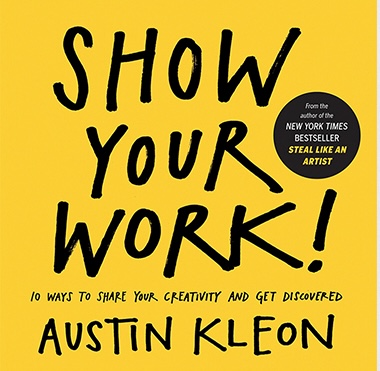
I define myself as a creative. Professionally I work a lot on the design, engineering and strategy and personally I have a range of pursuits from entrepreneurship to writing to music. Show Your Work!: 10 Ways to Share Your Creativity and Get Discovered by Austin Kleon offers a useful guide for any creative seeking to get more of their work out there.
“The problem with hoarding is you end up living off your reserves. Eventually, you’ll become stale. If you give away everything you have, you are left with nothing. This forces you to look, to be aware, to replenish. . . . Somehow the more you give away, the more comes back to you.” —Paul Arden
Creativity is, in my opinion, largely all about creative problem-solving. Most of what I do (and most of us do) is learn and solve problems. While we often mythologize the initial getting of ideas and glorify the completion, most of the action is in the middle phase of developing that idea and executing on it until it goes out into the world. Creativity is hard for a whole host of reasons, which is why I spend time each year reading and thinking about creativity in general and about my own specific approaches to acting creativity and finishing my creative outputs.
Favorite Philosophy Book: The Arts and the Definition of the Human by Joseph Margolis
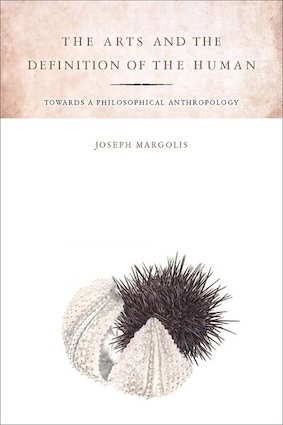
although Homo sapiens is a “natural-kind” kind, human beings—human selves—really have no nature, are no more than artifacts, histories, hybrids of biology and culture, the sites of certain transformed powers peculiar to human possibility.
Joseph Margolis’ “The Arts and the Definition of the Human” was a strange book to stumble into this past year and led me down quite a rabbit hole looking at human nature and how to define it. Margolis’ book presents a complex and multifaceted exploration of human nature, culture, and the arts. Interestingly he points out the interconnectedness of different fields, such as philosophy, science, and the arts, suggesting they cannot be understood in isolation. For example, “the work of the philosophy of science can rightly be very far removed from the discoveries of the philosophy of art” (p 3).
Rejecting a substantive and universal human nature, Margolis argues that we as humans are more than biological entities; we are also products of culture and history, which he succulently labels as “hybrids of biology and culture” (p 2).
- Historicity and Cultural Relativism: In order to understand human existence, it is important to consider historical context and cultural relativism, because “history confirms that history is itself perspectived, remembered in small bursts compatible with sleep and uncertain memory” (p 5)
- Human Perception and Interpretation: Margolis discusses how human perception and understanding are culturally and historically conditioned. He asserts, “our competing conceptual pictures of the world are no more than salient fragments that collect under the canopy of encultured thought” (p 4).
This book eventually lead me to further reading on questions related to what is human nature and how to find and define authenticity.
Two Books of Human Nature:
- Blank Slate by Steven Pinker
- Human Nature and Limits of Science by John Dupré
Three Books on Authenticity (with links to my review, write-up and quotes):
- Book Notes: The History and Ethics of Authenticity: Meaning, Freedom, and Modernity by Kyle Michael James Shuttleworth
- Book Notes On Being Authentic by Charles Guignon
- Book Notes The Ethics of Authenticity by Charles Taylor
Favorite History Book: Panama Fever by Matthew Parker
Apart from actual wars, it is the costliest project ever yet attempted in history, as ambitious a construction as the Great Pyramids. Hundreds of millions of francs were invested—and lost—during the ten-year struggle by the French in the 1880s, and the Americans spent nearly $400 million between 1904 and 1914, in the days when a couple of dollars a day was a good working wage. Although much shorter than the canal at Suez, it cost four times as much and required three times the amount of excavation.
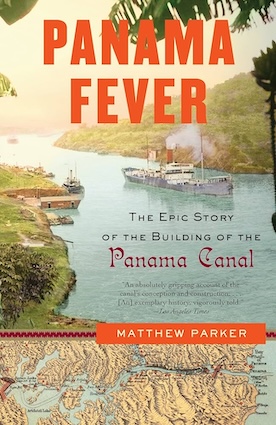
The Panama Canal is one of the largest human construction projects ever and largest at its time of completion. Panama fever: the epic story of one of the greatest human achievements of all time–the building of the Panama Canal by Matthew Parker is a real-page turner describing the multi-decade, multi-country effort to bridge the Atlantic and Pacific Oceans. Like most technological and engineering feats, it required a combination of innovation, luck, timing and taxing effort.
Honorable mentions:
- Electric War - AC/DC Battle between Edison and Tesla/Westinghouse
- River of Doubt - Ex-President Teddy Roosevelt’s adventure to survey an unmapped Brazilian river.
- Tractor Wars - Following Ford’s Model T and rise of cars, another industrial battle unfolds between multiple companies seeking to modernize and industrialize farming.
- Stairway to Heaven: A Journey to the Summit of Mount Emei - Located in a remote area of modern Sichuan province, Mount Emei is one of China’s most famous mountains and has long been important to Daoists and Buddhists. Wonderful retelling of famous Chinese travelogues.
- Rough-hewn Land - Geological tale from birth of California to the Rocky Mountains
- The Last Duel - A dramatic conflict between French Norman neighbors in Medieval Europe culminating in a blow-by-blow retelling of dueling knights.
Conclusion and Reflection
So, how can you read nearly 80 books in a year while also maintaining a full-time job, part-time side hustles and several creative hobbies?
The short answer is I put in the time.
I believe book reading is one of the best activities you can do for yourself regardless of your job, interests or age. Mentally and cognitively it’s one of the best things you can do your brain. It also has been shown to reduce stress and improve mental health too.
When it comes to learning and growing, books are arguably one of the most concentrated forms of knowledge available. It often takes a writer 3 or 4 years to produce a book that can be read in 5 or 6 hours, meaning you as a reader are getting roughly 6 months of knowledge concentrated into each hour or two reading.
Beyond just the learning and cognitive benefits, time spent reading translates into (in my humble opinion) a better choice for how to use your time too. Our hyper capitalistic society seems to endless nudge us to consume, both in terms of purchases and passive watching and swipping. While there is nothing inherently wrong with spending your time on games, TV or other activities, I continue to rebel against mindless consumption and most social media usage. Instead, I put much of my leisure attention and time to book reading.
Over this past year, book reading helped support me through creative and professional challenges. It complemented by time usage and pursuit of various goals. It offered me unique insights for my cients I work with and and startups I mentor. It enabled me to navigate creative challenges making music, writing and imagining and design products and services.
As I continue to do work at the intersections of data and reflection, self and biology, I’m excited by books I get to read and topics I get to learn and grow with next!

